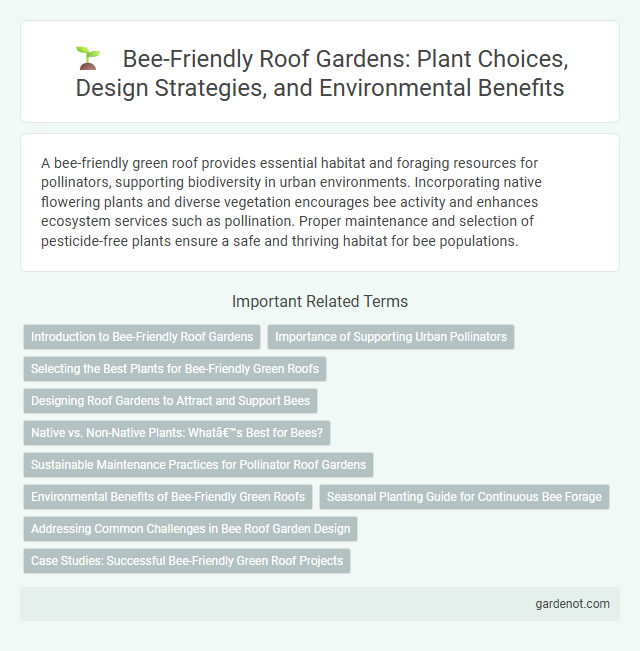A bee-friendly green roof provides essential habitat and foraging resources for pollinators, supporting biodiversity in urban environments. Incorporating native flowering plants and diverse vegetation encourages bee activity and enhances ecosystem services such as pollination. Proper maintenance and selection of pesticide-free plants ensure a safe and thriving habitat for bee populations.
Introduction to Bee-Friendly Roof Gardens
Bee-friendly roof gardens create vital habitats by incorporating native flowering plants that provide nectar and pollen essential for pollinators like honeybees and bumblebees. These green roofs support biodiversity, improve urban air quality, and enhance ecological connectivity in cityscapes. Designing with diverse plant species ensures sustained food sources, fostering healthy bee populations and contributing to environmental resilience.
Importance of Supporting Urban Pollinators
Bee-friendly roofs create essential habitats for urban pollinators, fostering biodiversity and improving ecosystem services in densely populated areas. Supporting native bee species on green roofs enhances pollination of local flora, contributing to food security and the resilience of urban agriculture. Integrating pollinator-friendly plants and structures into green roofs helps maintain healthy bee populations, crucial for sustaining urban environmental health.
Selecting the Best Plants for Bee-Friendly Green Roofs
Choosing the best plants for bee-friendly green roofs involves selecting native wildflowers, herbs, and flowering shrubs that provide abundant nectar and pollen throughout the growing season. Species such as lavender, coneflowers, and bee balm attract diverse pollinators while thriving in shallow, well-drained substrates typical of green roofs. Incorporating a variety of bloom times ensures continuous forage, supporting healthy bee populations and enhancing urban biodiversity.
Designing Roof Gardens to Attract and Support Bees
Designing bee-friendly roof gardens involves selecting diverse, native flowering plants that bloom throughout the growing season to provide continuous nectar and pollen sources for bees. Incorporating shallow water features and nesting habitats such as bare soil patches or wooden bee hotels enhances the roof's suitability as a habitat for various bee species. Using organic, pesticide-free practices ensures a safe environment, promoting healthy pollinator populations and biodiversity in urban areas.
Native vs. Non-Native Plants: What’s Best for Bees?
Native plants on bee-friendly green roofs provide essential nectar and pollen that local bee species have adapted to over millennia, supporting their foraging efficiency and overall health. Non-native plants may offer floral resources but often lack the specific chemical cues and nutritional profiles native bees require, potentially reducing habitat quality and pollination benefits. Prioritizing native plant species ensures enhanced biodiversity, improved ecosystem resilience, and sustained pollinator population growth on green roofs.
Sustainable Maintenance Practices for Pollinator Roof Gardens
Sustainable maintenance practices for bee-friendly green roofs emphasize native plant selection and seasonal watering schedules to support pollinator health and biodiversity. Incorporating organic pest management and minimal chemical use reduces harm to bee populations and enhances ecosystem resilience. Regular monitoring and adaptive management ensure optimal floral resources and habitat continuity for sustainable pollinator roof gardens.
Environmental Benefits of Bee-Friendly Green Roofs
Bee-friendly green roofs enhance urban biodiversity by providing vital habitats and forage resources for pollinators like honeybees and native bees, contributing to the stabilization of local ecosystems. These roofs improve air quality by filtering pollutants and reducing carbon dioxide levels, while also mitigating the urban heat island effect through natural insulation. Integrating native flowering plants on green roofs supports pollination services that benefit surrounding agricultural areas and promote greater environmental resilience.
Seasonal Planting Guide for Continuous Bee Forage
A bee-friendly green roof incorporates a seasonal planting guide rich in native wildflowers and nectar-rich plants to ensure continuous forage for pollinators throughout spring, summer, and fall. Selecting species such as early-blooming crocus, mid-season clover, and late-season goldenrod creates a diverse bloom timeline that supports diverse bee populations. Implementing layered plant structures with varied flowering times maximizes nectar availability and promotes healthy urban pollinator habitats.
Addressing Common Challenges in Bee Roof Garden Design
Bee-friendly green roofs enhance urban biodiversity by incorporating native flowering plants that provide essential nectar and pollen sources for pollinators. Addressing challenges such as limited soil depth and water retention involves using lightweight, nutrient-rich substrates combined with efficient irrigation systems to sustain healthy bee habitats. Strategic plant selection and modular planting designs improve resilience against harsh rooftop conditions, ensuring year-round forage and shelter for bees.
Case Studies: Successful Bee-Friendly Green Roof Projects
Case studies of bee-friendly green roof projects demonstrate significant biodiversity benefits and urban pollinator support, such as the Chicago City Hall green roof, which increased native bee populations by 50% within two years. The Brooklyn Grange rooftop farm in New York serves as a successful model, providing habitat for over 30 bee species while producing fresh vegetables. These projects highlight the importance of native flowering plants and sustainable maintenance practices in maximizing pollinator activity and ecological resilience on green roofs.
Bee-friendly roof Infographic

 gardenot.com
gardenot.com